A New Examination of Sauropod Trackways – No Swimming Here
A number of rather strange sets of sauropod tracks are known from numerous locations. The tracks, trace fossils of these extremely large, herbivorous dinosaurs don’t show the typical template of front feet and hind feet, but in a number of cases these quadrupeds have left tracks where only two of the feet have left prints behind. Could these dinosaurs have walked on their hind legs?
A Rearing Diplodocus (CollectA Dinosaur Model)
Picture credit: Everything Dinosaur
For models and replicas of sauropods and other prehistoric animals: CollectA Prehistoric Life Figures.
Certainly, there is some suggestion that these dinosaurs could rear up onto their hind legs, a number of palaeontologists have speculated that very young sauropods may have had the ability to run short distances on their hind legs only, perhaps to escape predation, but the idea of the Sauropoda being facultative bipeds – surely not? However, we still have to try to explain these mysterious tracks where only hind feet (pes) or hand prints (manus) tend to be preserved. If the hand prints only have been preserved does this mean Camarasaurus performing cartwheels – surely not!
Could Sauropods Swim?
Up until very recently the idea that sauropods, the likes of Brontosaurus, Apatosaurus, Diplodocus et al were aquatic animals held sway in palaeontological circles. It was assumed therefore that these herbivores could swim and that they would have been very much at home in such environments, with the water helping to support their huge body weights.
A number of fossilised trackways were cited as evidence of an aquatic lifestyle for these dinosaurs. For example, the American palaeontologist Roland T. Bird proposed that a trackway that consisted almost exclusively of the hand prints of sauropods from the Cretaceous of Texas was evidence of “swimming sauropods”, the herd “punting” off the bottom with their forelimbs, whilst the rear legs floated clear of the lake or river bed.
Swimming Sauropods – A Herd of Sauropods “Punting” Along
Picture credit: Giovani Caselli
A Trace Fossil Preservation Phenomenon
Light may have been shed on these puzzling prints. An international team of scientists from the China University of Geosciences in collaboration with researchers from the Royal Veterinary College and the University of Bristol have concluded that the two print tracks of quadrupeds may not be preserving swimming behaviour, or indeed any peculiar walking behaviour for that matter. It is the substrate over which the creatures were walking that has caused this phenomena.
Writing in the journal “Scientific Reports”, the research team analysed a number of trackways preserved in Lower Cretaceous rocks in the Hekou Group of Yongjing County (Yanguoxia), Gansu Province (northern China) . Quadrupedal tracks of Sauropods are known from the same location, but one set of tracks is characterised by the preservation of the hind feet only, notably just traces of the hind claws.
Sauropod Tracks from the Site
Picture credit: Scientific Reports
An Ichnogenus
The picture above shows a set of typical sauropod tracks, note the rounded, roughly circular prints and the “narrow gauge” of the tracks – left and right prints close together. These prints would have come from a sauropod, but which one (or which ichnogenus), we at Everything Dinosaur don’t know.
However, other tracks show just the hind feet claws.
Lead author of the paper, Lida Xing (School of the Earth Sciences and Resources, China University of Geosciences) stated:
“Nobody would say these huge dinosaurs could stagger along on their hind legs alone – they would fall over. However, we can prove they were walking because the prints are the same as in more usual tracks consisting of all four feet, it’s just that here, we don’t see the hand prints. If they had been swimming, with the hind legs dangling down, some of the foot prints would be scratch marks, as the foot scrabbled backwards.”
The strange prints are interpreted as having been caused by the substrate the animals were walking over. The combination of soft mud and silt led to the claws being pushed deeper into the ground to get more grip as the animals moved along. These traces were preserved as registrations in an underlying layer of sand. As most of the sauropod’s weight was to the rear of the animal, the hind legs pressed down deeper and thus only the rear prints or partial rear prints were preserved.
A Map Showing the Digit Only Impressions Left in the Sediment (Yanguoxia site 2)
Picture credit: Scientific Reports
Quadrupedal Sauropod Tracks
In the locality, quadrupedal sauropod tracks are preserved. These are interpreted as having probably been made slightly earlier on relatively firm substrates prior to the deposition of the soft mud and silt.
A Photograph (A) and a Line Drawing (B) of the Best Preserved Sauropod Print from the Trackway
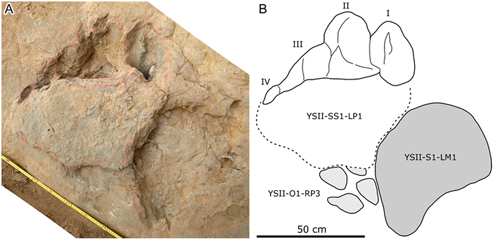
Photograph (A) and line drawing (B) of best preserved sauropod print in association with sauropod manus and a print from an indeterminate ornithopod.
Picture credit: Scientific Reports
The picture above shows a sauropod left pes print (YSII-SS1-LP1) from the site. Immediately behind the print is a partial left hand print from a sauropod (YSII-S1-LM1). Underlying these prints is the track of an ornithopod (YS11-O1_RP3) that crossed this substrate some time earlier. The Gansu Province locality is well-known for its dinosaur footprints and tracks. Something like two hundred tracks and individual prints have been found to date. They represent a rich fossil assemblage with theropod, ornithopod as well as sauropod tracks being recorded.
No Evidence of Swimming Sauropods
The scientists conclude that there is no convincing evidence of sauropods swimming. The trackways do not provide clear evidence of sauropods going for a swim. All is not lost for those who believe that these animals were at home in the water.
Co-author of the study, Professor Mike Benton (Bristol University) explained:
“This is not to say that sauropods did not swim. We are simply suggesting that a closer study of the details of fossil footprints and the sediments can suggest a rather less romantic idea. The loss of hand prints is down to sedimentology, not dinosaur behaviour.”
Everything Dinosaur Comments
A spokesperson from Everything Dinosaur commented:
“When one considers the appetites of such dinosaurs, it is likely that they had to migrate large distances to find food. Indeed, there is plenty of evidence in the fossil record to indicate that sauropods tended to live in herds and that they did travel far and wide to find enough plant material to fill their vast guts and to visit suitable breeding sites and nesting locations.”
The spokesperson added:
“If this is the case, then it can be assumed that from time to time these herds had to cross waterways, so it is very probable that, just like most vertebrates today, they could swim. After all, elephants are known to take to the water and have even been recorded swimming considerable distances in the sea.”


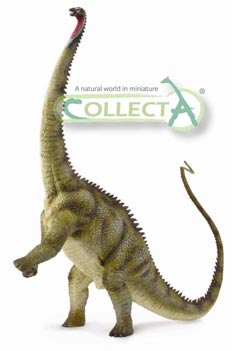
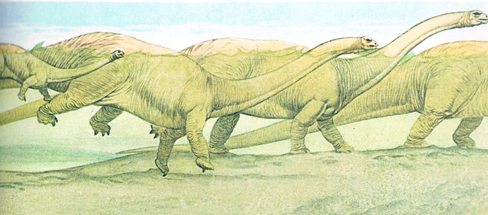
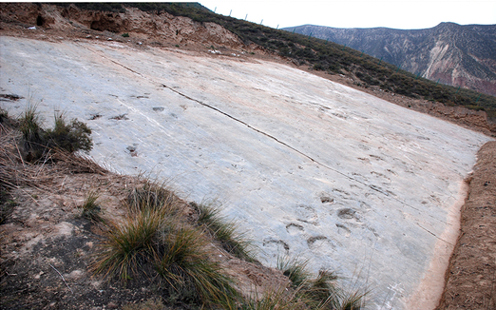
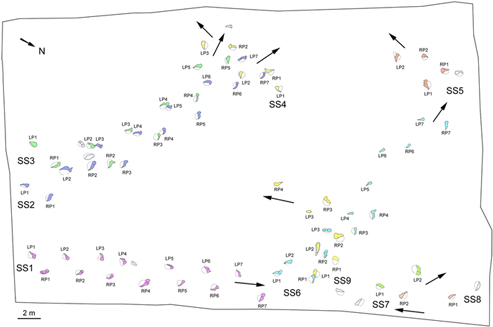




Still, I believe it is plausible that all those big sauropods were in fact aquatic animals and that they were able to grow so heavy because of the buoyancy of the lakes they lived in. Their long necks had the same function as the vacuum cleaner tube.
They could scour the bottom very efficiently with their long necks. ..like the modern day swan.
Besides, these sauropods were slow and their physique was helpless against large predators.
A predator like T-Rex would not be able to attack forcefully in 5 m of water. It would simply be outweighed and knocked down.
So water would have given sauropods much needed protection.